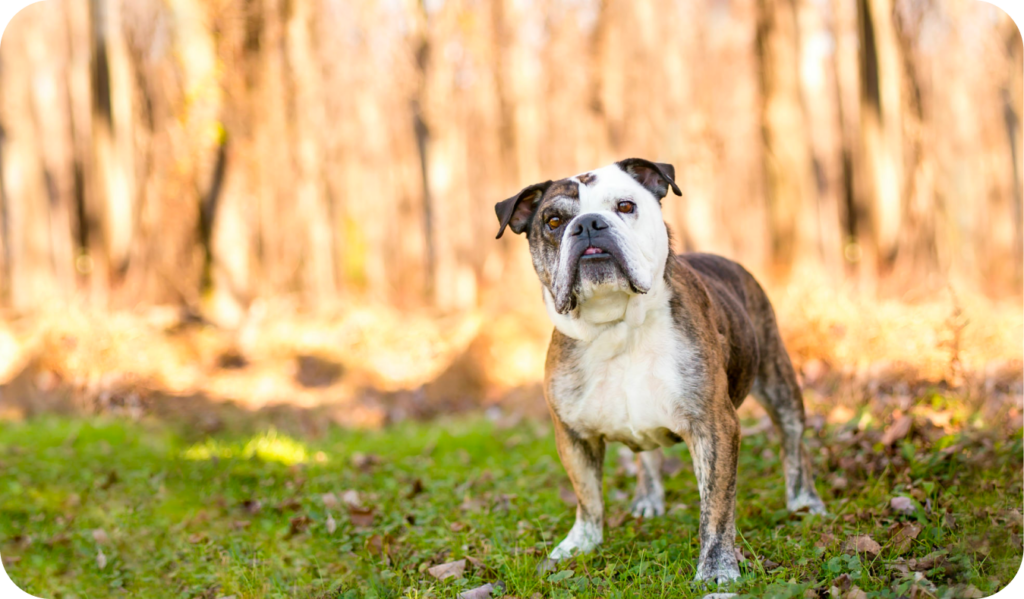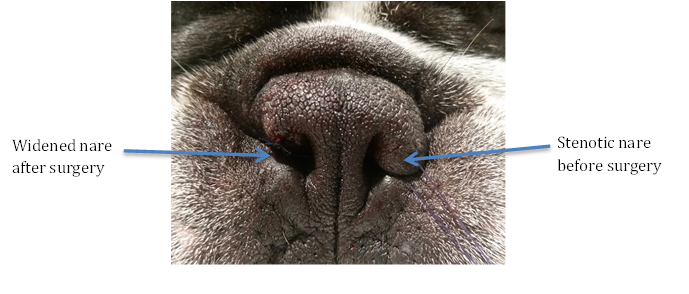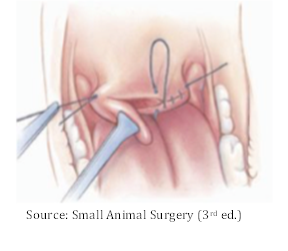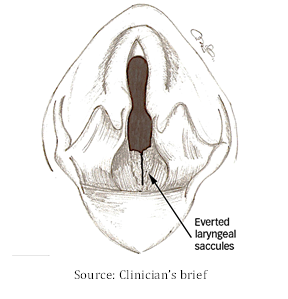Client Resources
Brachycephalic Obstructive Airway Syndrome (BOAS)

Brachycephalic dogs and cats are considered to be breeds with short noses and “squashed” faces. Examples of these breeds include English bulldogs, French Bulldogs, Pugs, Persian cats and many others. Years of breeding have resulted in significant changes in their facial anatomy, causing a series of side effects that cause many health problems for these breeds. The normal soft tissue and bony structures of breathing passageways are all still present, but are pushed into a compacted skull. This means that many structures are narrowed, or overlap with each other, resulting in obstructed airflow and difficulties in breathing. It is often likened to permanently breathing through a straw.
There are several conditions that form BOAS, as well as other gut and spinal disorders that are common in these breeds.
Many brachycephalic animals have stenotic nares (narrowed nostrils) and narrowed nasal passages. This means that more effort is required to breathe through the nose, as there is an increase in airflow resistance. This in turn increases negative pressure (pressure sucking inwards) in the throat, contributing to other airway disease.
Stenotic nares can be surgically widened by removing a small section of nostril cartilage. This can help to improve airflow through the nostrils and nasal passages.

The hard and soft palates separate the nasal cavity from the mouth. The hard palate forms the roof of the mouth, and soft palate extends into the throat. The soft palate in brachycephalic breeds is often similar in length to dolichocephlic breeds (long nosed, e.g. Greyhound, Saluki, etc.) and mesocephalic breeds (medium nosed, e.g. Labrador, Border Collie, etc.), but in a much shorter skull.

This means that the soft palate extends further into the throat than normal and interferes with the upper trachea (windpipe). This is one of the causes of snoring and excessive breathing noise. The soft tissue of the palate is pulled into the upper trachea during inspiration (in-breath) and vibrates with the negative pressure. The vibration not only causes noise, but the negative pressure and movement causes inflammation and swelling of the soft palate. Over time, the inflammation and swelling causes chronic changes to the soft palate, causing it to interfere even more with the airway. This creates a continuous cycle of inflammation and swelling.
The soft palate can be surgically trimmed to reduce its interference with the trachea. This can reduce breathing noise, and reduce negative pressure with each breath as the trachea opening is less obstructed.

There are two small soft tissue sacs just inside the opening of the trachea (windpipe), adjacent to the vocal folds. Increases in negative pressure during breathing can cause these sacs to evert (protrude) into the airway. Similar to elongated soft palates, this causes further narrowing of the airway, increasing negative pressure, and progressively worsening the process over time.
These saccules can be surgically removed, however may redevelop over time.
We can provide surgical care for stenotic nares and elongated soft palates, but with some restrictions. Due to the progressive nature of BOAS, surgery becomes riskier as the animal ages. At North Maclean Family Vet, we are able to provide surgical care for stenotic nares and elongated soft palates in patients under 1 year of age. After 1 year of age, chronic changes in the upper airway increase the risk of post-operative complications.
We are not able to perform surgery for everted laryngeal saccules or for tonsils. These are recommended to be specialist surgeon procedures as they indicate that the BOAS in that patient is more progressed, and carries greater post-operative risk.
The risks during the surgery are no different to that of anaesthesia for any other procedure. We can provide you with an anaesthetic information sheet that explains many of the common risks. The main risks specific to BOAS patients are in the post-operative period. Any surgery causes some swelling and inflammation, and while we do our best to minimise this, swelling can temporarily cause airflow to worsen. Swelling is often worse in older patients with more chronic change, compared to young patients. This is one of the reasons that we restrict our surgical cases to those under 1 year of age.
Post-operative swelling that causes further obstruction to the airways can result in your pet very suddenly struggling to breath (dyspnoea). In severe cases, this obstruction can be life threatening, and some patients may require emergency and critical care to help them breath normally in the post-operative period.
Seeking veterinary advice early in your pet’s life makes a big difference to their long-term outcome. Early surgical intervention can reduce the severity of BOAS and the associated chronic changes. We are never able to completely solve the problem, but we aim to improve it.
Considerations for specialist surgery and post-operative care are recommended for any patient, but particularly for adult or senior patients. Specialist surgical centres have 24-hour post-operative care, meaning that there are nurses and vets onsite to help your pet if they experience any post-operative complications.
At North Maclean Family Vet, we cannot provide 24-hour care. This means that our BOAS patients must be at home during their recovery. If your pet has surgery at North Maclean Family Vet, then strict post-operative recommendations apply. Your pet must be kept as quiet as possible and strictly rested for the first 24 hours. Your pet must not exert themselves, as we want their breathing pattern to remain as slow and calm as possible to minimise the risk of obstruction occurring. If your pet shows any signs of difficulty breathing then you must seek emergency vet care. You should feed soft foods for the first 3 days, and you should monitor for signs of coughing or vomiting. If these signs occur, then a revisit with your vet is recommended to manage those signs.
Our intention is never to cause anyone to fear anaesthesia or surgery, but BOAS patients and their surgeries do carry certain risks that you must be aware of. With appropriate case selection, appropriate referral care, and good post-operative home-care, many risks can be minimised and complications can be avoided.
Chronic inflammation of the upper airways can lead to inflammation of the pharyngeal tonsils (at the back of the throat). This inflammation can cause swelling, and increase the risk of oropharyngeal (throat) infections.
Many brachycephalics also suffer from gastrointestinal problems such as irritable bowel syndrome, chronic gastritis and oesophagitis. These can cause chronic vomiting and diarrhoea.
There are also several developmental disorders commonly seen in brachycephalic breeds. Some brachycephalic dogs suffer from an abnormally developed trachea that is significantly smaller and/or weaker than a normal dog. This can result in further breathing difficulty, collapse of the trachea and sudden collapse. Hernias of the diaphragm (the muscle that separates the chest from the abdomen) around the oesophagus as it passes through are also common, and can contribute to vomiting and digestive disorders. Some individuals can also suffer from spinal diseases due to malformed vertebrae.
If you have more questions about Brachycephalic Obstructive Airway Syndrome and the associated surgeries, then please contact our friendly staff on 07 3297 0803 or come in and speak with us.

